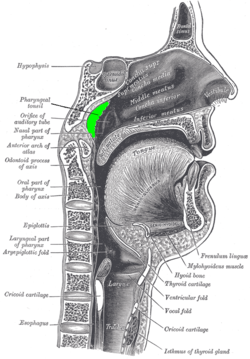Adenoid: Difference between revisions
m interwiki hr |
|||
| Line 36: | Line 36: | ||
Enlargement of adenoids, especially in children, causes an atypical appearance of the face, often referred to as adenoid facies. |
Enlargement of adenoids, especially in children, causes an atypical appearance of the face, often referred to as adenoid facies. |
||
Adenoid |
Adenoid faces have a rather colorful history. In "Cymon and Iphigenia", [[John Dryden]] draws, perhaps unconsciously, a most vivid and accurate pen picture of the '''adenoid face''': |
||
:"The fool of nature stood with stupid eyes |
:"The fool of nature stood with stupid eyes |
||
Revision as of 17:37, 12 April 2009
This article needs additional citations for verification. (November 2007) |
| Pharyngeal tonsil | |
|---|---|
 Location of the adenoid | |
| Details | |
| Identifiers | |
| Latin | tonsilla pharyngea |
| MeSH | D000234 |
| TA98 | A05.3.01.006 |
| TA2 | 5186 |
| FMA | 54970 |
| Anatomical terminology | |
Adenoids (or pharyngeal tonsils, or nasopharyngeal tonsils) are a mass of lymphoid tissue situated at the very back of the nose, in the roof of the nasopharynx, where the nose blends into the mouth.
Normally, in children, they make a soft mound in the roof and posterior wall of the nasopharynx, just above and behind the uvula.
Pathology
Enlarged adenoids, or adenoid hypertrophy, can become nearly the size of a ping pong ball and completely block airflow through the nasal passages.
Even if enlarged adenoids are not substantial enough to physically block the back of the nose, they can obstruct airflow enough so that breathing through the nose requires an uncomfortable amount of work, and inhalation occurs instead through an open mouth.
Adenoids can also obstruct the nasal airway enough to affect the voice without actually stopping nasal airflow altogether.
Adenoid facies
Enlargement of adenoids, especially in children, causes an atypical appearance of the face, often referred to as adenoid facies.
Adenoid faces have a rather colorful history. In "Cymon and Iphigenia", John Dryden draws, perhaps unconsciously, a most vivid and accurate pen picture of the adenoid face:
- "The fool of nature stood with stupid eyes
- And gaping mouth which testified surprise."[1]
George Catlin in his humorous and instructive book The Breath of Life, published in 1862, illustrates adenoid faces in many engravings and advocates nose-breathing.[1]
Removal of the adenoids
Surgical removal of the adenoids is a procedure called adenoidectomy.
Adenoids may be removed if they become infected, causing symptoms such as excessive mucus production.
Carried out through the mouth under a general anaesthetic (or less commonly a topical), adenoidectomy involves the adenoids being curetted, cauterised, lasered, or otherwise ablated.
Histology
Adenoids, unlike other types of tonsils, have pseudostratified columnar ciliated epithelium.[2]
They also differ from the other tonsil types by lacking crypts. The adenoids are often removed along with the tonsils. This can cause a very sore throat for about a week and rather unpleasant breath. Most people's adenoids are not even in use after a person's third year, but if they cause problems they must be taken out or they may otherwise shrink.
See also
References
- ^ a b Wylie, A, (1927). "Rhinology and laryngology in literature and Folk-Lore". The Journal of Laryngology & Otology. 42 (2): 81–87.
{{cite journal}}: CS1 maint: extra punctuation (link) CS1 maint: multiple names: authors list (link) - ^ Histology at KUMC lymphoid-lymph06
